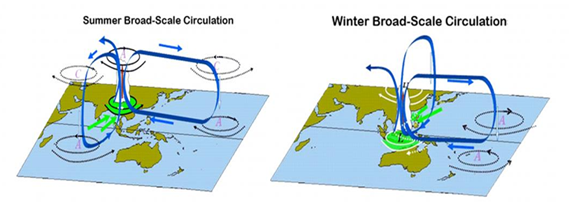
Regional Working Group on Asian-Australian Monsoons
About us
The Asian-Australian Monsoon Working Group works with the CLIVAR/GEWEX Monsoons Panel in dealing with the regional aspects of the Asian-Australian Monsoon (AAM) system, comprising the South Asian, East Asian, and Australian monsoons.
About Asian-Australian Monsoon
Monsoons have been defined as a transition of prevailing winds between summer and winter seasons which often results in distinct rainfall seasonal variations. The fundamental driver of all monsoon systems is the solar heating of the land during the spring and early summer season that helps to establish a land-sea temperature difference.
During boreal summer the Asian continent, being warmer than the surrounding Pacific and Indian Oceans, triggers a low-level flow carrying moisture inland from nearby oceans. Thus, moisture is rained out during convection over monsoonal regions. Due to the change of seasons, the peak solar heating moves equatorward and then into the Southern Hemisphere, thereby leaving the Asian continent to cool more than the adjacent oceans. As a consequence, the winds reverse, and the monsoon rainfall migrates to Australia. In the transition back from boreal winter to summer season, the rainfall onset in the Asian continent tends to be sudden and disconnected from the austral summer rainfall in Australia. Associated with the monsoonal wind reversal, some regions in the AAM region can experience two monsoon rainy seasons, such as the north-easterly and south-westerly monsoons in parts of Southeast Asia.
In boreal winter, the cold and dry air of the East and South Asian winter monsoons originates as far north as Siberia and flows across the equator towards the Southern Hemisphere, picking up moisture from the warm oceans and feeding the abundant Maritime Continent and Australian summer monsoon rains. In boreal summer, winds from the Southern Hemisphere cross the equator and bring abundant summer monsoon rains over South, Southeast, and East Asia, where nearly 60% of the world’s population reside and where agriculture is the main source of subsistence. Maritime Southeast Asia has a complicated wet-dry seasonality based often on the interactions between monsoon winds and mountains or coastlines.
Understanding the AAM variability and improving forecast quality across timescales can provide significant socio-economic returns by maximizing the benefits of monsoon rainfall while reducing the impact of extreme weather such as floods or droughts which can have severe consequences for life, livelihoods, infrastructure, and agriculture. The AAM system represents the dominant variation in the climate of the Asia-Australia region, with profound local, regional, and even global impacts.
Summer and Winter Broad-Scale Circulations
A monsoon is characterized by convergent cyclonic lower-tropospheric flow and divergent upper-tropospheric flow in the summer hemisphere. This pattern is opposite in the winter hemisphere. These broad-scale summer and winter circulation features in the Indo-Pacific region are illustrated in the figure below. While ascent is associated with the convergence of lower-tropospheric flow, descent occurs outside the ascending region promoted by radiative cooling in the anti-cyclonic upper-tropospheric flow. Broad-scale ascent (descent) is thermodynamically associated with adiabatic cooling (warming) which is balanced by enhanced (suppressed) latent heat release from rainfall.
The figure (left panel) shows a cyclonic circulation with ascent over Southeast Asia centred on Myanmar during boreal summer. As the season progresses, the cyclonic circulation shifts south-eastward across Southeast Asia to just north of Australia (below figure, right panel) during boreal winter (austral summer). Thus, enhanced precipitation associated with monsoons is generally favoured over South Asia, East Asia and Continental Southeast Asia during boreal summer, and over North Australia during austral summer. But islands and peninsulas in Maritime Southeast Asia often experience enhanced precipitation on their windward mountain slopes or coastlines whether in boreal summer or winter due to mesoscale interactions between mountain-valley or land-sea breeze systems and the broad-scale monsoon circulation.

Asian-Australian Monsoon Variability
The AAM exhibits variability on a range of timescales from diurnal and synoptic through sub-seasonal to seasonal and interannual. Variability within each of the regional monsoons manifests in different ways according to their location, although many of these regional modes are dynamically interrelated.
For the AAM region, some significant modes of mean monsoon rainfall variability are broadly categorized into: (i) diurnal cycle (~1 day); (ii) synoptic scale ( < 7 days) ; (iii) quasi-biweekly oscillation (QBWO; 10-20 days); (iv) intraseasonal variability (30-60 days) including the Boreal Summer Intraseasonal Oscillation (BSISO, sometimes referred to as the Monsoon Intraseasonal Oscillation, MISO, and, over India, as the active/break cycle) and the Madden Julian Oscillation (MJO). Cross-scale interactions frequently occur between these modes.
The diurnal cycle of precipitation explains a large fraction of total summer rainfall over land and surrounding oceans in AAM region that includes high rainfall areas such as the Himalayan range, coastal regions of western India, western Myanmar, and the Maritime Continent. Diurnal variation is strongly modulated by synoptic-scale disturbances and intraseasonal oscillations (e.g., BSISO and QBWO). Synoptic variability includes monsoon troughs, low-pressure systems, monsoon depressions, cyclones, offshore vortices, etc. The QBWO mode is a westward propagating mode from the western North Pacific/South China Sea along the monsoon trough with a dominant wavelength of 6000 km and speed of 4.5–6 ms−1. This mode is also one of the main controls on the active/break cycles of the Indian monsoon system, along with the BSISO mode. The BSISO is a prominent northward/north-eastward propagating mode from the equatorial Indian Ocean. Another intra-seasonal variation, the MJO, propagates along the equator eastward from western Indian Ocean and sometimes crosses the Maritime Continent into the Pacific Ocean. BSISO and MJO provide significant modulation to rainfall over the broader area ranging from South Asia, Southeast Asia, East Asia, and Australia.
Drivers of the Asian-Australian Monsoon
The dominant driver that governs year-to-year variations of AAM is the El Niño Southern Oscillation (ENSO) phenomenon, i.e., El Niño warming and La Niña cooling in the central and eastern equatorial Pacific Ocean. El Niño (La Niña) is normally associated with suppression (enhancement) of Asian-Australian monsoon rainfall. The Walker Cell, i.e., easterly flow in the lower troposphere and westerly flow in the upper troposphere, during boreal summer and winter affected by ENSO are depicted respectively in left and right panels in the figure above. During El Niño (La Niña), the Walker Cell weakens (strengthens) in positive feedback to the weaker (stronger) equatorial Pacific currents responsible for the sea surface warming (cooling). The strength of the ascending branch of the Walker Cell directly affects the strength of the AAM circulation away from the equator.
Another important influence which impacts on the year-to-year variability in AAM rainfall is the Indian Ocean Dipole (IOD) – a coupled ocean-atmosphere phenomenon over the Indian Ocean akin to ENSO. A positive (negative) Indian Ocean Dipole with cooling (warming) in the eastern (western) equatorial Indian Ocean results in above (below)-normal rainfall over the Indian subcontinent. The IOD is also a main contributor to Australian and Maritime Southeast Asian rainfall variability, with positive (negative) phases corresponding to reduced (increased) austral summer monsoon rainfall. Furthermore, positive (negative) IOD events are often associated with El Niño (La Niña). When the IOD and ENSO are in phase, the impacts of El Niño and La Niña events are often most extreme over the region, while when they are out of phase the impacts of El Niño and La Niña events can be diminished.
Monsoon inter-annual variability could also be teleconnected with the North Atlantic Oscillation. Internal dynamics connected with the intra-seasonal monsoon fluctuations may contribute to the inter-annual monsoon variability. The seasonal mean rainfall is thought to be made up of a large-scale seasonally persistent component and the average of the intraseasonal fluctuations. The extent to which the former affects the latter remains a topic of research. The role of land-surface processes, land-air interactions and the thermal and dynamical impacts of Tibetan Plateau are also important to understand the AAM.
Bottle necks for improved prediction of Asian-Australian Monsoon
- The majority of the operational coupled models underestimate monsoon rainfall over South Asia.
- State-of-the-art models are able to represent teleconnections between ENSO and Asian monsoon with the correct signs but overestimate the magnitudes. However, the majority of the operational models fail to get the IOD - AAM teleconnections.
- Better understanding and model representations of monsoons processes and inter-linkages among the various regional components are required.
- Lack of a consensus index to operationally characterise monsoon patterns in Southeast Asia is an obstacle to relate IPCC research findings to regional operational needs.
Aims of the WG-AAM
The Asian-Australian Monsoon Working Group has been refreshed in 2025 with membership comprising 17 renowned scientists from the international community. Our members can be seen at WG on Asian-Australian Monsoons Members and include representatives from countries throughout the Asian-Australian monsoon region: Australia, China, India, Indonesia, Japan, Nepal, the Philippines, Singapore, Sri Lanka and the UK, and from different disciplines including underpinning research, operational forecasting and observations. We have therefore positioned this Working Group to address three key overarching aims:
- To promote and facilitate active engagement and interaction among research, operational predictions and stakeholders in the different regional monsoon components of the Asian-Australian Monsoon system;
- To provide authoritative information on process understanding, models' fidelity in their (regional component) representations, and forecast skill assessment
- To identify key research priorities for advancing our understanding of the monsoon system and its forecasts.
To address these aims, we are currently focussing on three science themes: Asian-Australian monsoon processes and teleconnections, regional monsoon characteristics, and high-impact weather events.
Regional Working Groups
Regional Working Group Members
| Name | Designation | Institute | Photos |
|---|---|---|---|
| Lin Wang, | Co-Chair | Institute of Atmospheric Physics (IAP), Chinese Academy of Sciences, Beijing, China |  |
| Thea Turkington | Co-Chair (Co-chair, Monsoons Panel) | Centre for Climate Research Singapore (CCRS), Singapore |  |
| Tieh Yong Koh, | Member | Asia Pacific Institute of Experts, Singapore | 
|
| Gill Martin | Member | Met Office Hadley Centre, Exeter, UK |  |
| Raghavendra Ashrit | Member | National Centre for Medium Range Weather Forecasting (NCMRWF), Noida, Uttar Pradesh, India |  |
| Wei-Ting Chen | Member | National Taiwan University (NTU), Chinese Taipei | 
|
| Hatsuki Fujinami | (Member, WWRP/WGTMR) | Institute for Space-Earth Environmental Research (ISEE), Nagoya University, Nagoya, Japan | 
|
| Kieran Hunt | Member | University of Reading, Reading, UK |  |
| Shiromani Jayawardena | Member | SAHF Climate and Weather Service, Regional Integrated Multi-Hazard Early Warning System (RIMES), Thailand | 
|
| Indira Kadel | Member | Department of Hydrology and Meteorology (DHM), Kathmandu, Nepal |  |
| Donaldi Permana | Member | Indonesia Agency for Meteorology Climatology and Geophysics (BMKG), Jakarta, Indonesia | 
|
| Joseph Basconcillo | Member | Philippine Atmospheric, Geophysical and Astronomical Services Administration (PAGASA), Quezon City, Philippines |  |
| Hui Su | (Member, CLIVAR/GEWEX Monsoons Panel) | The Hong Kong University of Science and Technology (HKUST), Hong Kong, China |  |
| Hiroshi Takahashi | (Member, CLIVAR/GEWEX Monsoons Panel) | Tokyo Metropolitan University, Tokyo, Japan |  |
| Tim Cowan | Member | University of Southern Queensland & Bureau of Meteorology, Australia | 
|
| Zizhen Dong | Member | Yunnan University, Kunming, China |  |
| Maheswar Pradhan | Member | Indian Institute of Tropical Meteorology, Pune |  |
